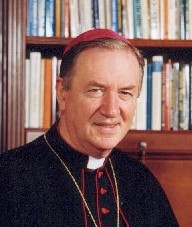
Muadhan (Moan) of Errigal Truagh
Address by Bishop Joseph Duffy in Errigal Cemetery
at Ecumenical Prayer Service
Pentecost Sunday, 31 May 2009.
Last year on Pentecost Sunday we visited Donagh old cemetery.
Where we are today is about six miles north of Donagh and very
much a companion site. Donagh and Errigal belonged to the barony
of Errigal Truagh and to the same medieval parish, divided only in
the 15th c. Because of its name Donagh claimed Patrician origin:
all Donagh sites are identified with Patrick. Errigal however has closer
contact with the local saint: Muadan/pronounced Moan/ Latinised Mellan.
From a look at the placenames there is every reason to believe that Moan belonged to both parishes, that he was of Donagh as well as of Errigal when both parishes were one.
What can we say of Moan? Possibly more than you would think, for the simple reason that the references have never been collected in one place. The name derives from an Irish word meaning ‘good or noble’. His feast is given in the Martyrology of Tallaght (the earliest of the martyrologies) on 30 August where he is described as a bishop.
Moan has links with both Patrick and Columcille. This means that the churches which followed his cult were taken over by the wider federation of monasteries which continued a visible Church presence when the original Episcopal structure founded by Patrick and his contemporaries broke down. In the 9th-century Tripartite Life of Patrick, Moan is named as of Ramoan, now Ballycastle, Co Antrim. It mentions Muadan martrach, ‘Moan of the relics’, which may imply that his original cult began there. We are also told that Moan had a son, Erclach, also venerated as a saint. If other similar examples are anything to go by, this detail may mean that Moan was a convert to Christianity in the time of Patrick.
The cult of Moan turns up in Kilmodan, west of Glasgow in the direction of Argyll in Scotland. This Scottish Modan needs more teasing out because there seems to have been two of them. The saint of Kilmodan was a 6th-c. abbot who used to retire in solitude in the mountains near Dumbarton. Churches at Stirling, Roseneath and Falkirk are dedicated to him. He was a follower of Columba of Iona. Feast 4 Feb. The second Scottish Modan was a bishop in the 8th c. His silver-head-relic was carried formerly in procession at Philorth (Fraserburgh) to bring down rain or improve the weather in other ways. Feast 14 Nov. Because of the reference to the relic he may have been our Moan of Ramoan, co Antrim. While the reference to the 8th c. would leave him two centuries too late, we are not dealing with precise dates here.
In the south of Ireland there were two centres of the cult, Kilmodain, co Longford , and Ballymodan, now Bandon, in west Cork. Bishop MacNamee (a native of this diocese) in his History of the Diocese of Ardagh, went to a lot of trouble to identify this Kilmodain as Kilmahon, co Longford, but near Cloone, co Leitrim. There is a story told against Moan in one of the Lives of Columcille which is worth realting. It seems Columcille and his companions arrived at Moan’s monastery late on a Friday evening. For their lodging they were given a filthy barn and for food, although it was a day of abstinence, they were given a hairy pig, not cooked, and a leaking pot in which to do the cooking. Columcille knew he was being insulted and promptly cursed the place and everybody in it. Clearly, an anti-Patrick story as well as showing us that our early Irish Christians were not all saints. As Colgan lists this saint as a disciple of Patrick, this effectively equates him with the saint of Errigal where we are today.
The other Modan site was Bandon, co Cork, a place well known to Bp Jackson. What is interesting about this site is that it was an example of the strict division between Gaelic parishes and Norman parishes in the 13th c. The O’Mahonys who were Gaelic settled west of Bandon while the Barrys who were Norman, endowed the new parish of Ballymodan in the same area.
To get back to where we are, Moan occurs in Ceasach Móin, the modern Ivy Hill, which adjoins Mullanacross, quite close by. He also gave his name to a 17th-c. ballybetagh in the southern end of the parish, named alternately Ballymony and Ballymodagh in the 1640 Down Survey. The ballybetagh lists 20 townlands in Truagh and two In Donagh, Cornacreeve and Derrylea. Now between these two townlands in Donagh, in the same estate is Tiramoan at Emy Lough. This means that Muadan, or Moan, was the early local saint of the Uí Méith, the early people who inhabited this whole area. It also makes it very probable that Donagh itself, which literally means a church, originally had a second component, Moan, giving us Donagh Moan, as the complete name for the parish. This, I am convinced, is the explanation behind the bland inter grunnas, idir mhóin, which took on here in the late Middle Ages when the earlier history was forgotten.
A last point. Among many others, the cult of three Irish saints found its way into Belgium in the 11th and 12th centuries. These were Monon, whose cult turns up in the Ardennes, in east Belgium, Livinus at Brabant and Dympna at Geel near Antwerp. Dympna is the best known of these, and we associate her with Tydavnet. Livinus was, and is, the patron of Killeevan. I have no doubt that the first of these, Monon, is a form of Moan, patron of Donagh and Errigal Truagh.

